Brief

We don’t often hear the word “factory” applied to the IT services industry, where people are the fundamental asset. But leading IT services firms are quickly acquiring industrial proportions, driven by their global scale, the proliferation of services offered and the wide range of delivery models. Cognizant, for example, scaled from 100,000 employees to 210,000 in only five years, and Tata Consultancy Services employs more than 319,000 people across 46 countries.
When organizations reach this size, siloed and subscale management processes and systems can no longer ensure optimal performance. Adopting a factory mindset helps managers envision a more rational approach, one that relies on better planning, lean operations and more sophisticated supply chain management. Ideally, this mindset ensures smoother operations, freeing capacity for senior executives to focus on developing new priorities—for example, serving the digital needs of enterprise customers.
Sandeep Nayak, a partner in Bain's Telecommunications, Media and Technology practice, shares the five traits of leading IT services companies.
Across the broad landscape of IT services firms—which for the purposes of our survey and discussion includes IT services, business process outsourcing (including knowledge processes), research and development, and engineering services—we see a wide variation in performance. Economies of scale explain some but not all of this variance, and our analyses suggest that many firms are performing well below what their scale might suggest (see Figure 1). Bain benchmarked the performance of global firms and Indian firms. Our findings indicate four key capability areas that are critical to efficient performance in current operations and a fifth that is becoming increasingly important as clients adapt to new digital models:
- Talent supply chain
- Managing project costs
- Automation
- Lean delivery overhead
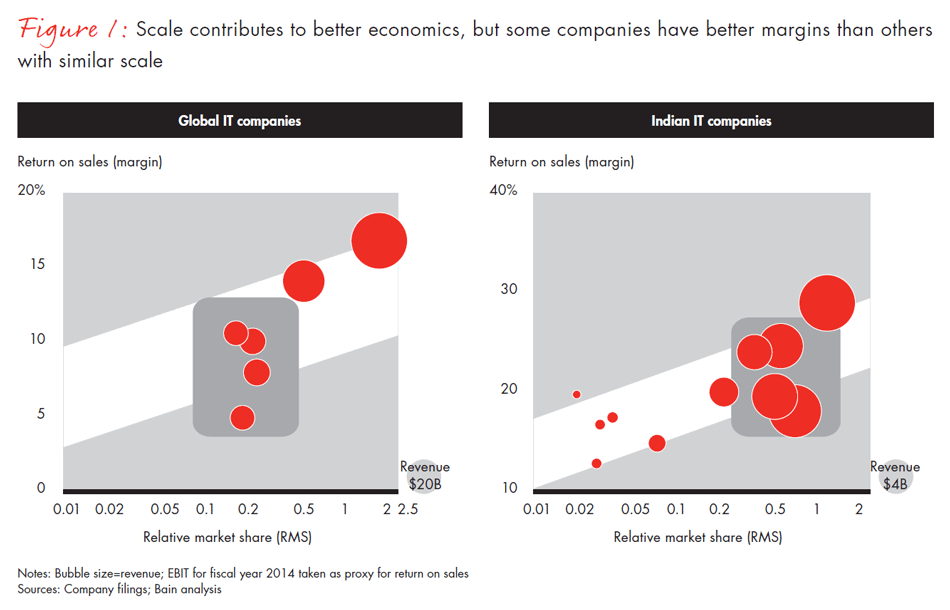
The fifth capability area, Agile and DevOps, addresses the changing needs of clients as they adapt to meet new priorities such as omnichannel experience and single views of customers and inventory. Agile software development principles encourage closer and more iterative collaboration between developers and software users. DevOps focuses on continuous development and a close working relationship between development and IT’s daily operations. Both are key to success, as innovation speeds the pace of product development and delivery.
Clients want to fund their new digital ventures with savings in their legacy IT operations—the large enterprise applications and database systems that will remain necessary for many years to come. Increasingly, they will expect their IT partners to manage these services efficiently so that, rather than seeing costs rise for traditional IT, they can funnel potential savings and investment to the new digital platforms that will help generate growth and revenue. They are looking to IT services firms for cost savings on traditional work, along with innovation and agility in new digital initiatives. An efficient factory approach must be at the heart of this change.
Talent supply chain
A well-designed and efficient talent supply chain allows companies to forecast both revenue and resource requirements accurately, plan and consume talent capacity optimally, match the right resource to a client requirement significantly faster and reduce hiring costs. It solves for faster time to revenue at high utilization rates. The economic advantage can be significant—for example, raising utilization rates by 1% can improve margins by 20 to 30 basis points. A typical talent supply chain has six distinct processes and systems that need to be tightly integrated, starting with pipeline management and forecasting, followed by workforce management and raising resource requests, and ending with internal and external fulfillment. A wide range separates the performance of leaders from the lower end in supply chain maturity (see Figure 2).
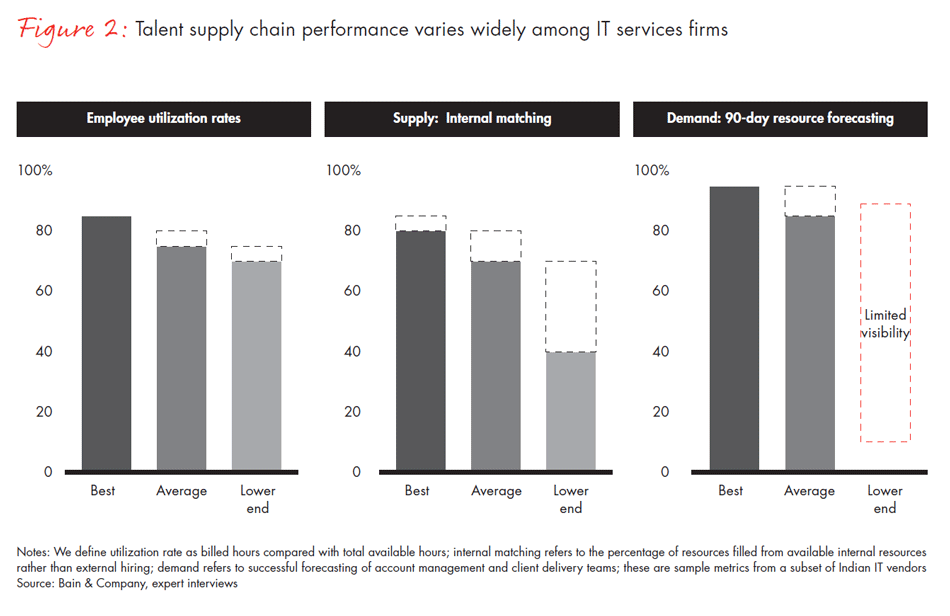
IT services firms can improve their talent supply management by focusing on five areas of concern:
- Poor upfront communication between supply and demand. Many firms capture very precise revenue information for new projects in their pipeline systems. Some also do a good job capturing similar information on project renewals and expansions. Most, however, fail to capture resourcing information at a level of detail required for forecasting and planning—and some don’t capture it at all. Good pipeline systems make this information available from the solution-development stage onward, and it becomes progressively more accurate as an opportunity moves toward negotiation and closure.
- Inconsistent forecasting. As with the pipeline, revenue forecasting tends to be consistent while resource forecasting varies widely, from rolling forecasts two quarters out to no forecasts at all. Effective forecasting ensures that the right people are available at the right time and place. Forecasts should describe the skills and locations that will be needed, from the project level up through entire business units. Some managers worry that forecasting takes too much capacity, but a good system can facilitate much of the work, and the payoffs can be powerful.
- Over-ordering. An accurate resource forecast maintains the supply-demand equilibrium. The demand side knows what to comply to, and the supply side knows what is coming its way. The absence of a good forecast can wreak havoc; in our experience, some companies may even have cumulative resources up to three and six times than what was required to serve underlying demand. Poor forecasting creates a spiraling cycle of over-ordering: Supply tries to fulfill the requests, and service levels fall drastically, while the demand side keeps inflating order volumes to compensate for the poor service levels. The net outcome is revenue loss—and some very dissatisfied customers.
- No single view of resources. IT services companies often create single-view solutions for their clients’ customer or inventory environments. Applying the same principles within their own organization would create systems with near-real-time information on every resource, covering multiple areas such as technical skill set, industry and process domains, current project with potential release date, performance history, and mobility details such as location, visa status and languages spoken. A system with a single view of the resource is probably the most important tool for creating an efficient supply chain. It forms the bedrock for resource capacity planning based on skill and location and matches resources to client requirements quickly. Few companies have deployed and effectively used comprehensive single-view systems.
- Unclear decision rights. Turf wars can result when staffing decision rights are murky, as managers compete to retain good people—often at the expense of higher-priority projects. Although the problem is well known, many companies still struggle to balance control between central management and the outlying business units.
Leaders in talent supply management break silos and take a comprehensive view to ensure that the systems integrate tightly and that accurate information flows both ways. Strengthening a weak system for managing the talent supply chain requires changes to the process, system and behaviors—and it can take 18 months or longer.
Managing project costs over their lifetime
All IT services firms experience project cost overruns. Some are better than others at limiting their damage. Our survey indicates that the larger IT services firms in India, those with annual revenue above $2 billion, have less severe cost and effort overruns than their smaller Indian counterparts or global firms (see Figure 3).
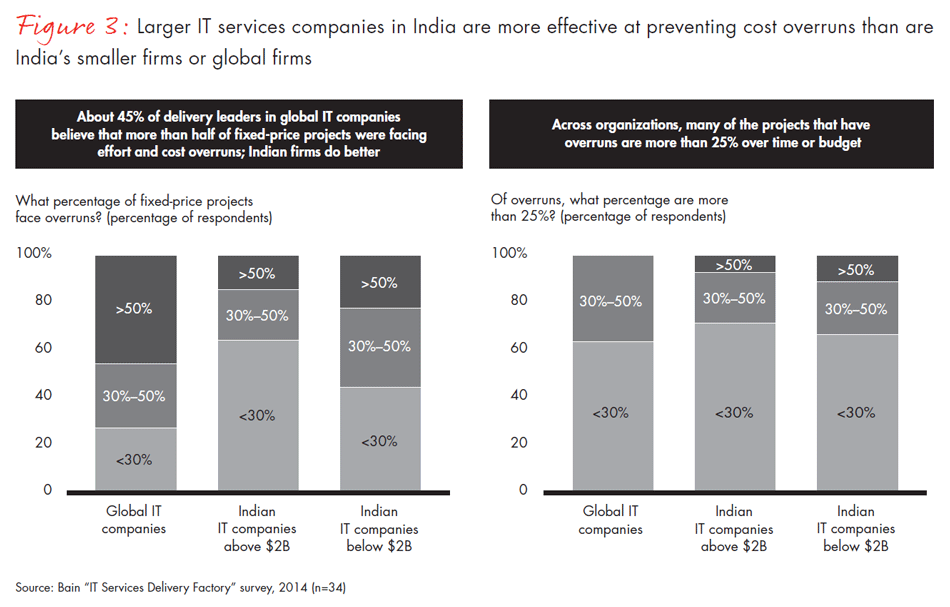
One reason for overruns lies in the way that firms bid on fixed-price projects. They expect profits to grow over time as investments taper and as the effects of automation and experience improve productivity and reduce costs. Based on these expectations, they set a baseline of deliverables, including service-level agreements, timelines, revenue, costs and other features such as the team composition and expectations about productivity and quality. Too often, scope creep and change requests alter the economics of the project, and if the firm fails to redefine the baseline, the expected gains can fail to materialize. Our survey identified companies at three levels of maturity on this spectrum.
- Baseline once. These companies don’t have systems to re-baseline programs with every change request. Without an accurate baseline, a program that appears to be reasonably profitable could do more—and vice versa.
- Baseline basic metrics. These firms baseline revenue, margins, effort and other surface-level metrics such as pyramid, onsite–offshore ratio and contractual buffers. They gain a clear understanding of relative economic performance but with little insight into root causes. Periodic reviews generate recommendations that are far too simplistic—for example, “need to improve margins by 200 basis points, flatten pyramid structure.”
- Baseline all metrics. Leading firms baseline key productivity and quality assumptions. A governance meeting in this environment for an underperforming program leads to actionable outcomes—for example, a 150-basis-point improvement through a fundamental shift in unit productivity by automating five tasks and better allocating work to reduce current high individual idle times in two areas.
Three actions can help companies improve in this area. First, setting up a robust contract management system with tight processes can ensure that planners capture baselines and revisit and reset them when required. Second, a comprehensive delivery analytics platform can provide accurate project performance data. Finally, strong governance processes help capture deviations from the baseline and fix root causes. A pilot project with a few accounts is a good way to start, then radiating the successful program throughout the company.
Automation
Automation in an IT services environment is complicated because tools and methodologies vary from one project to the next, and even similar projects can differ due to essential customization. Even so, our survey found that automation is on the rise, faster in some places than in others (see Figure 4).
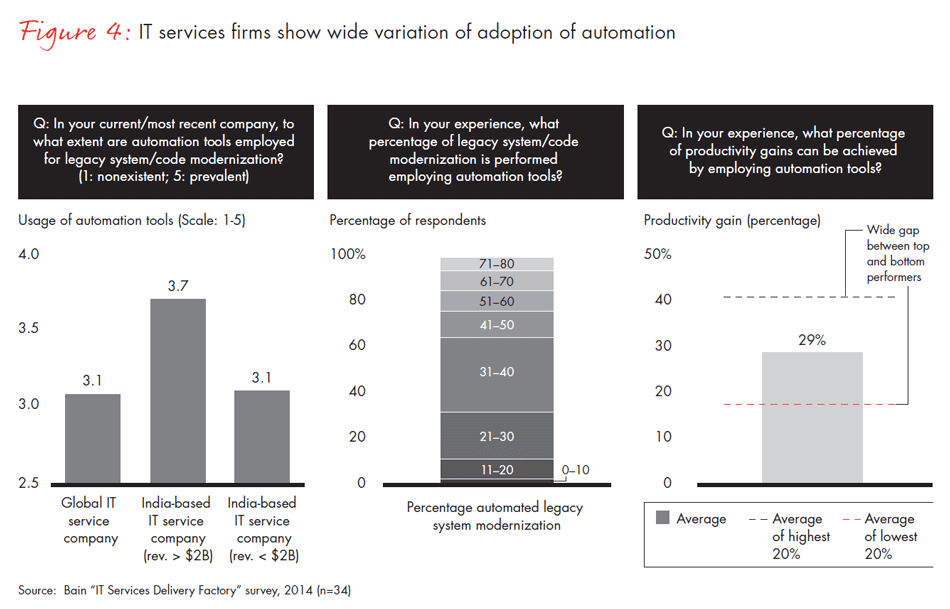
Survey respondents said that the biggest hindrance to greater adoption of automation tools isn’t the complexity of automation, but rather a lack of organizational focus on developing automation capabilities, followed by inconsistent tool performance and the lack of standardized tools. To some executives, complexity is an argument against automation. To others, it just means that automation cannot be done piecemeal and should be elevated to a companywide program, managed through centers of excellence across different service lines.
These centers of excellence need to do three things to create value:
- Embrace new technology. Teams developing automation processes should be trying new tools to find out which are viable, learning from customizations across different environments and committing those lessons to organizational memory. Over time, the company can develop a powerful knowledge repository of methodologies and reusable programs.
- Engage across program lifecycle. Experts from the center of excellence get involved during the proposal stage, through transition and at periodic intervals in steady state. This can provide a significant commercial edge at the point of sale and sustained economics thereafter.
- Standardize across organization. Train delivery personnel across service lines to adopt standard automation tools and methodologies in their projects. This would set a minimum acceptable bar for automation across different types of projects in the organization.
A key question is who keeps the benefits from automation. Should the services firm keep it, pass the savings along to the client, or some of both? This question is often so difficult and potentially touchy that managers put off automation to avoid dealing with it. Executives should deliberate carefully since, in many cases, sacrificing some revenue in the short term could lead to greater revenue in the long term.
Lean delivery overhead
As IT services companies scale, it becomes increasingly challenging to structure delivery resources in a balanced pyramid—that is, with the appropriate number of managers at various levels and with no unwieldy spans. Large IT companies in India tend to do a better job of tapping into the full potential of their most senior resources and managing an optimal pyramid (see Figure 5).
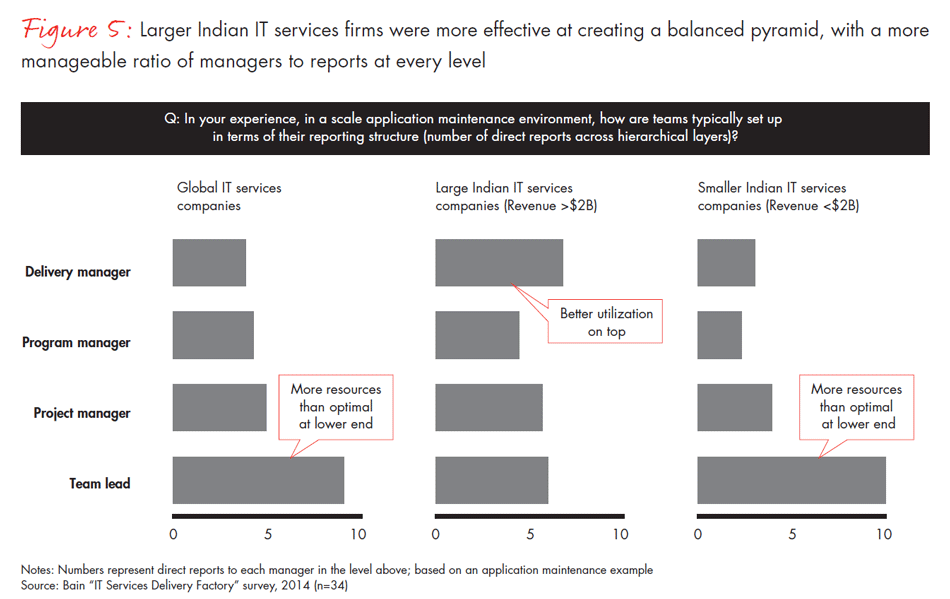
This can be a contentious topic within IT services companies. Some companies struggle to apply lean principles at the top of their delivery pyramids. Structural guidelines and benchmarks, such as the ones mentioned below, can be very helpful. However, executives will need to make some very hard decisions about which employees are most valuable to future prospects and which may need retraining.
- Standardize spans. For program managers and below (that is, project managers and team leaders), it is important to have well-defined spans based on the type of program or project. For example, application development projects executed in an agile model will likely have less span at the team leader level than an application maintenance project or an end user computing service desk program, where team members are doing similar work on waterfall-style projects. These benchmarks should typically be in the form of ranges to accommodate delivery complexity.
- Be customer-centric and ready for the future. The next two levels, typically delivery managers and partners, should ideally be allocated to customers and accounts based on future potential and complexity. For example, a $25 million account that is expected to double in three years with expansions across multiple locations will likely require as heavy a leadership structure today as a $50 million account that is expected to stay flat. Executives should create account clusters based on current size, future growth potential and expected rise in complexity. Complexity could have multiple parameters such as stakeholder and delivery locations, and the number of service lines delivered.
- Revenue coverage for the most senior personnel. As with delivery partners and managers, the roles and expectations for business unit delivery heads depend on forecasts of the unit’s revenue potential, as well as the complexity of its operations. Senior delivery personnel are critical for winning new business and managing the teams that deliver services to clients. Our survey finds they are an unhappy bunch, with a significant number saying they would not recommend their jobs to a friend (with an industry Net Promoter ScoreSM of just 6). Any new thinking in delivery overhead structures will also require rethinking these leaders’ support systems. Most delivery leaders say that they spend much more time on day-to-day operations and tactical decisions rather than focusing on strategic activities and account farming opportunities.
Preparing for new operating models
Traditional IT and new digital models will coexist for many years, but the share of work applied to new digital ventures will probably grow at the expense of traditional projects, particularly at global IT services firms (see Figure 6). Our survey found Agile and DevOps on the rise, and these methodologies are likely to characterize much of the digital build work in the foreseeable future.
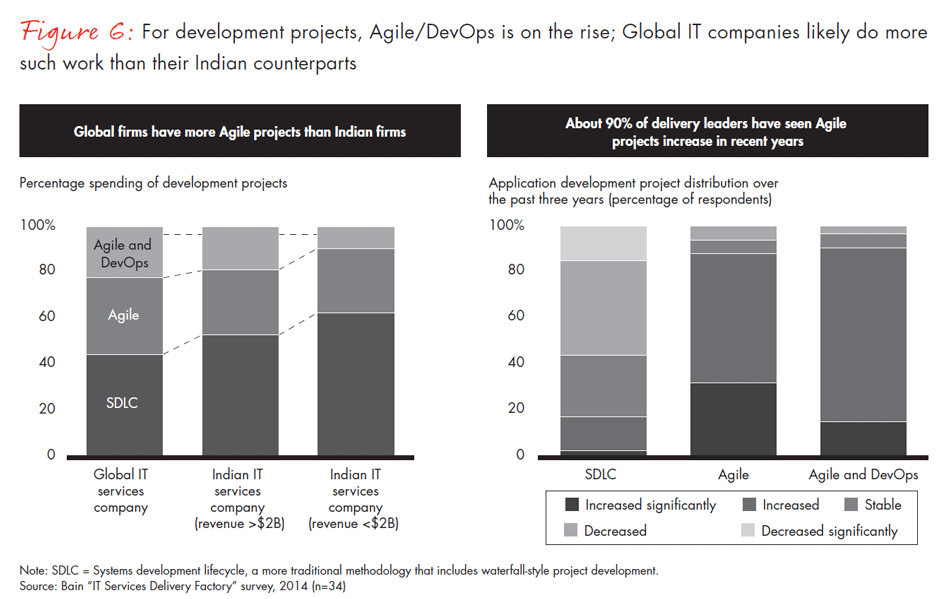
While IT services providers are moving up the experience curve, our survey indicates that three areas require incremental focus:
- New benchmarks. As methodologies change, so should benchmarks for productivity and quality. IT services companies should begin capturing current project and program metrics to arrive at a robust set of internal benchmarks over the next few years. External benchmarking should capture activity at some of the more advanced technology companies that are cutting development cycles drastically.
- Quality controls. Some companies are behind the curve in institutionalizing quality processes specific to Agile and DevOps. Others conduct periodic peer reviews consistently for all projects.
- Training and talent development. Many firms will need to build up their Agile and DevOps capabilities with institutionalized training and talent development strategies that estimate future demand for capabilities and then tailor programs to ensure their staff is prepared as jobs come their way.
While it seems most companies will want to adopt Agile and DevOps models to keep up with the pace of digital business, many are struggling to adopt these models internally and have yet to think about outsourcing or offshoring projects that depend on them. IT services companies that are unable to conceptualize and work within client environments run the risk of becoming order takers. Customers could take all development control in-house and use IT services firms as resource vendors—something that is already happening with end customers that have pioneered adoption of this methodology.
Path for the future
The concept of the factory, lean and quick in a complicated environment, is an apt model for IT services companies. Today, their capabilities and maturity levels vary widely. Some have seen strong sales and account management practices backed by evolved (if overcomplicated) customer relationship management systems, but they fail to address the supply side of the firm. Some have tight delivery management practices and optimal use of automation, but in pockets and not pervasive across the organization. Evolution in most companies has been a mixed bag driven by the presence (or absence) of a burning need and business unit or functional leaders who want to make a difference. In most cases, the gaps are well known and talked about, but are somehow not executed with the future in mind.
Now is the right time to address these gaps, and doing so requires a pervasive, organization-wide effort with a C-level sponsor. As executives consider how to begin a transformation, they should keep in mind several key points.
- Change takes time. Reinventing an organization—even making significant changes—can take 18 to 24 months or more. A strong and sustained sponsorship spine is important, to ensure the effort does not run out of steam in an environment where quarterly outcomes can often trump long-term evolution.
- Design is important, but teams must manage execution carefully to achieve the right outcomes. Robust governance is key to effective implementation.
- Systems will play a key role in most cases. Process and system design and implementation need to happen in parallel, and preferably under the same leadership, to ensure information is not lost.
- Organizational capacity will also be a key consideration for any initiatives. Only a few can run in parallel, and sequencing is important.
Finally, many of the factory constituents run the risk of being positioned as cost improvement initiatives, which often lead to immediate resistance. Most of these improvements lead to significant revenue upside as well, and so executives should position them correctly to keep stakeholders invested.
Sandeep Nayak is a partner with Bain & Company in Mumbai. Mark Brinda is a Bain partner based in New York. Stephen Phillips is a partner in Bain’s London office, and Bhanu Singh is a Bain partner based in New Delhi and Silicon Valley. All four work with Bain’s Global Technology practice.





